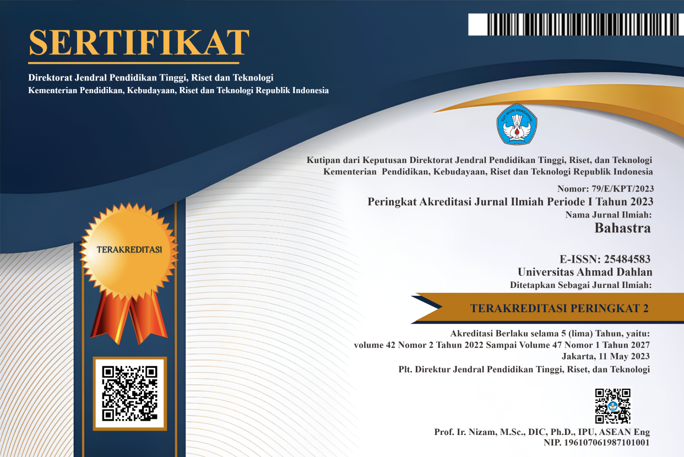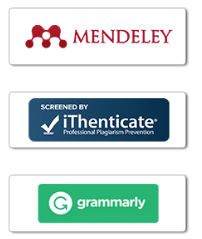The effectiveness of mobile-based teaching materials for academic writing in hybrid learning on students’ academic writing ability
DOI:
https://doi.org/10.26555/bs.v44i1.635Keywords:
Teaching materials for academic writing, mobile learning, hybrid learning, academic writing abilityAbstract
Mobile-based teaching materials for academic writing are flexible to be implemented in various learning models. Therefore, this study aims to investigate which is more effective between mobile-based teaching materials in hybrid learning and teaching materials in form of handouts in direct instruction to produce students’ academic writing ability. This study is quasi experimental design in which the population is all of students in second semester at Indonesian language and literature department of IKIP PGRI Bojonegoro. They are consisted of 72 students. Research samples are taken using simple random sampling. Test is utilized to obtain the data. Moreover, its hypothesis is tested using t-test. Result of study shows that in the significance level of 0,05, it equals 1,6992. While the value of t0,05;70 = 1,6669. Based on t table, the value of DK = . tobs DK. In other words, H0 is rejected. It can be concluded that mobile-based teaching material of academic writing skill in hybrid learning is more effective to produce students’ academic writing ability than the teaching materials in form of handouts in direct instruction.
References
Al-Emran, M., Elsherif, H. M., & Shaalan, K. (2016). Investigating attitudes towards the use of mobile learning in higher education. Computers in Human Behavior, 56, 93–102. https://doi.org/10.1016/J.CHB.2015.11.033
Awang, H., Zakaria, M. Z., Al-Mashhadani, A. F. S., Mustapha, R., Yaakob, M. F. M., Yusof, A. M., Ramli, N., Rasdi, M. N. A., Jafar, M. F., Nawi, A., Zain, F. M., & Kasim, M. (2022). Tarannum Smart Learning Application: Embracing the beauty of tarranum through multimedia technology. International Journal of Evaluation and Research in Education (IJERE), 11(2), 897–906. https://doi.org/10.11591/IJERE.V11I2.22388
Bai, H. (2022). Students’ use of learning management system in hybrid learning: Mobile or not. In G. Marks (Ed.), Proceedings of International Journal on E-Learning (pp. 5–23). Association for the Advancement of Computing in Education (AACE).
Baki, A., & Güveli, E. (2008). Evaluation of a web based mathematics teaching material on the subject of functions. Computers & Education, 51(2), 854–863. https://doi.org/10.1016/J.COMPEDU.2007.09.003
Bennett, D., Knight, E., & Rowley, J. (2020). The role of hybrid learning spaces in enhancing higher education students’ employability. British Journal of Educational Technology, 51(4), 1188–1202. https://doi.org/10.1111/BJET.12931
Borglin, G. (2012). Promoting critical thinking and academic writing skills in nurse education. Nurse Education Today, 32(5), 611–613. https://doi.org/10.1016/J.NEDT.2011.06.009
Chen, B. H., & Chiou, H. H. (2014). Learning style, sense of community and learning effectiveness in hybrid learning environment. Interactive Learning Environments, 22(4), 485–496. https://doi.org/10.1080/10494820.2012.680971
Chokwe, J. M. (2013). Factors impacting academic writing skills of english second language students. Mediterranean Journal of Social Sciences, 4(14), 377–383. https://doi.org/10.5901/MJSS.2013.V4N14P377
Cilliers, C. B. (2012). Student perception of academic writing skills activities in a traditional programming course. Computers & Education, 58(4), 1028–1041. https://doi.org/10.1016/J.COMPEDU.2011.12.001
Criollo-C, S., Guerrero-Arias, A., Vidal, J., Jaramillo-Alcazar, Á., & Luján-Mora, S. (2022). A hybrid methodology to improve speaking skills in english language learning using mobile applications. Applied Sciences, 12(18). https://doi.org/https://doi.org/10.3390/app12189311
Crompton, H., & Burke, D. (2018). The use of mobile learning in higher education: A systematic review. Computers & Education, 123, 53–64. https://doi.org/10.1016/J.COMPEDU.2018.04.007
Fulantelli, G., Taibi, D., & Arrigo, M. (2015). A framework to support educational decision making in mobile learning. Computers in Human Behavior, 47, 50–59. https://doi.org/10.1016/J.CHB.2014.05.045
Hasanudin, C., & Fitrianingsih, A. (2018). Flipped classroom using Screencast-O-Matic apps in teaching reading skill in Indonesian language. International Journal of Pedagogy and Teacher Education, 2(0), 16-151–158. https://doi.org/10.20961/IJPTE.V2I0.25356
Hiasa, F., Supadi, S., Agustina, E., Afrodita, M., Lazfihma, L., & Yanti, N. (2023). Development of android-based learning media assisted by Thunkable Applications in literary history courses. BAHASTRA, 43(2), 221–233. https://doi.org/https://doi.org/10.26555/bs.v43i2.514
Hudaa, S. (2018). Efektivitas pembelajaran Bahasa Indonesia menggunakan pendekatan student active learning di jurusan Manajemen Fakultas Ekonomi dan Bisnis UIN Syarif Hidayatullah Jakarta. BAHASTRA, 38(1), 69–74. https://doi.org/http://dx.doi.org/10.26555/bahastra.v38i1.7300
Hung, Y. H., Chang, R. I., & Lin, C. F. (2016). Hybrid learning style identification and developing adaptive problem-solving learning activities. Computers in Human Behavior, 55, 552–561. https://doi.org/https://doi.org/10.1016/j.chb.2015.07.004
Hwang, G. J., & Chang, H. F. (2011). A formative assessment-based mobile learning approach to improving the learning attitudes and achievements of students. Computers & Education, 56(4), 1023–1031. https://doi.org/10.1016/J.COMPEDU.2010.12.002
Kazu, İ. Y., & Yalçın, K. Y. (2022). Investigation of the effectiveness of hybrid learning on academic achievement: A meta-analysis study. International Journal of Progressive Education, 18(1), 249–265. https://doi.org/https://doi.org/10.29329/ijpe.2022.426.14
Keck, C. (2014). Copying, paraphrasing, and academic writing development: A re-examination of L1 and L2 summarization practices. Journal of Second Language Writing, 25(1), 4–22. https://doi.org/10.1016/J.JSLW.2014.05.005
Khan, A. I., Al-Shihi, H., Al-Khanjari, Z. A., & Sarrab, M. (2015). Mobile Learning (M-Learning) adoption in the Middle East: Lessons learned from the educationally advanced countries. Telematics and Informatics, 32(4), 909–920. https://doi.org/10.1016/J.TELE.2015.04.005
Li, L., Huang, F., Chen, S., Pan, L., Zeng, W., & Wu, X. (2020). Exploring the curriculum development in content and language integrated learning: A systematic review. International Journal of Evaluation and Research in Education (IJERE), 9(4), 1102–1113. https://doi.org/10.11591/IJERE.V9I4.20705
Liaw, S. S., Hatala, M., & Huang, H. M. (2010). Investigating acceptance toward mobile learning to assist individual knowledge management: Based on activity theory approach. Computers & Education, 54(2), 446–454. https://doi.org/10.1016/J.COMPEDU.2009.08.029
Lin, O. (2014). Student views of hybrid learning: A one-year exploratory study. Journal of Computing in Teacher Education, 25(2), 57–66. https://doi.org/10.1080/10402454.2008.10784610
Martin, F., & Ertzberger, J. (2013). Here and now mobile learning: An experimental study on the use of mobile technology. Computers & Education, 68, 76–85. https://doi.org/10.1016/J.COMPEDU.2013.04.021
Motiwalla, L. F. (2007). Mobile learning: A framework and evaluation. Computers & Education, 49(3), 581–596. https://doi.org/10.1016/J.COMPEDU.2005.10.011
Olapiriyakul, K., & Scher, J. M. (2006). A guide to establishing hybrid learning courses: Employing information technology to create a new learning experience, and a case study. The Internet and Higher Education, 9(4), 287–301. https://doi.org/10.1016/J.IHEDUC.2006.08.001
Prasetyo, H., Kristiyanto, A., & Doewes, M. (2019). The development of android-based mobile learning media in healthy lifestyle teaching materials for senior high school students. International Journal of Multicultural and Multireligious Understanding, 6(2), 188–194. https://doi.org/10.18415/IJMMU.V6I2.656
Şenel Esma. (2018). The integration of creative writing into academic writing ckills in EFL Classes. International Journal of Languages’ Education, 6(2), 115–120. https://doi.org/10.18298/IJLET.2869
Sugiyono. (2015). Metode penelitian pendidikan (pendekatan kuantitatif, kualitatif dan R & D). Alfabeta.
Suryani, I., Rasdawita, R., Wilyanti, L. S., & Priyanto, P. (2022). Development of online media based on the KIK-IRMA learning model on learning to write criticism and essays in the Indonesian language and literature education study program, Jambi University. BAHASTRA, 42(2), 132–147. https://doi.org/https://doi.org/10.26555/bs.v42i2.241
Tarrant, M., Dodgson, J. E., & Law, B. V. K. K. (2008). A curricular approach to improve the information literacy and academic writing skills of part-time post-registration nursing students in Hong Kong. Nurse Education Today, 28(4), 458–468. https://doi.org/10.1016/J.NEDT.2007.08.001
Widyaningrum, H. K., Pratiwi, C. P., Menggala, A. D., Hasanudin, C., & Fitrianingsih, A. (2022). Android Application Appy pie to support students writing stories skill through flipped classroom learning models. International Journal on Advanced Science, Engineering and Information Technology, 12(2), 530–538. https://doi.org/10.18517/IJASEIT.12.2.12719
Wu, W. H., Jim Wu, Y. C., Chen, C. Y., Kao, H. Y., Lin, C. H., & Huang, S. H. (2012). Review of trends from mobile learning studies: A meta-analysis. Computers & Education, 59(2), 817–827. https://doi.org/10.1016/J.COMPEDU.2012.03.016

Downloads
Published
Issue
Section
License
Copyright (c) 2024 Cahyo Hasanudin, Aida Azizah, Ayu Fitrianingsih, Nofia Fitriyana, Abather Saadoon

This work is licensed under a Creative Commons Attribution-ShareAlike 4.0 International License.

1.jpg)






